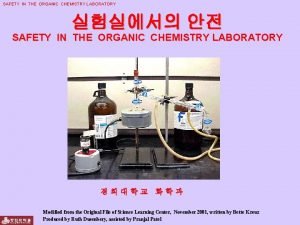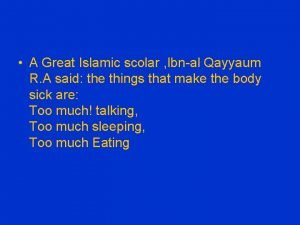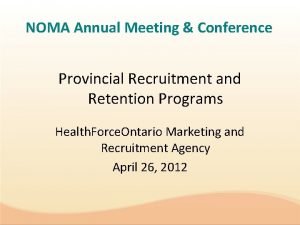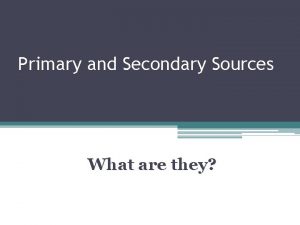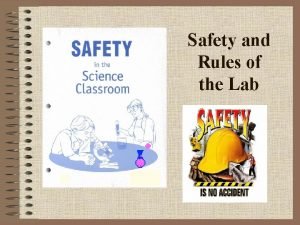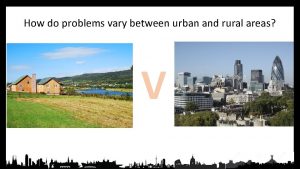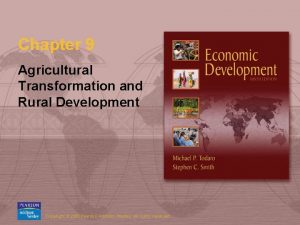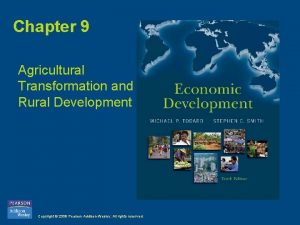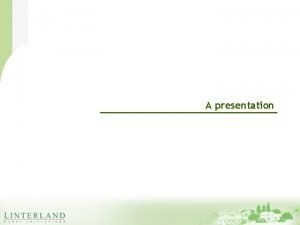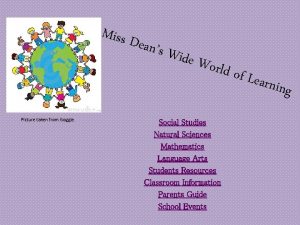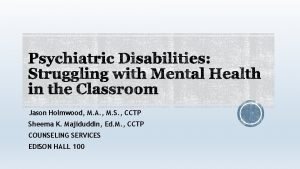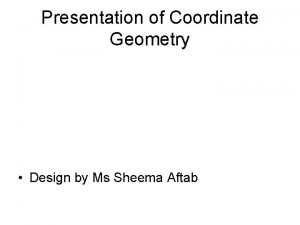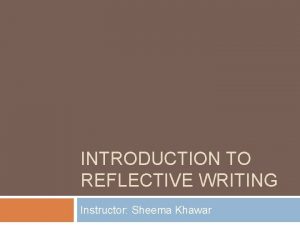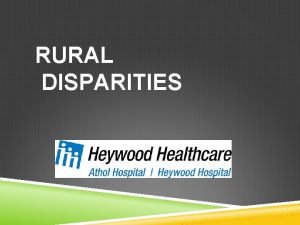Sheema rural source goggle Who and why rural














- Slides: 14

Sheema rural (source- goggle) Who and why? : rural out-migration in Uganda Case-study in Ankole sub-region, western Uganda Mbarara city (source- goggle) Samuel Tumwesigye Promoters: Prof. Anton Van Rompaey – KUL, Dr. Ronald Twongyirwe – MUST, Prof. Jean Poesen - KUL, Dr. Matthias Vanmaercke – KUL, Dr. Alfonse Opio – Gulu University, Uganda 1 11/01/2022 Faculty of Science; Department of Earth & Environment Science; Division of Geography & Tourism

Outline Context: rural-urban interaction SSA & Uganda (migration - urbanisation) consequences 11/01/2022 Rural out-migration prediction Who migrates? next steps Why migrate? Faculty of Science; Department of Earth & Environment Science; Division of Geography & Tourism

Context – urbanisation in SSA social & economic progress since 2000 • GDP per capita -> increasing at annual average of 5% • reduced extreme poverty and hunger • healthier population with reduced mother and child mortalities, increased life expectancy population growth at 1. 3% per year urbanization – 4% per year (UN-DESA/PD, 2020) Data Source: World Bank national accounts data, 2019 3 11/01/2022 Faculty of Science; Department of Earth & Environment Science; Division of Geography & Tourism

Context – Uganda’s urbanisation • pop growth -> 3. 2% /year since 2000 • Urban pop. 25% in 2020 • Urbanization rate: 6%, in 2019 (UBOS, 2020) Data Source: UBOS – 2019 population estimates 4 11/01/2022 Faculty of Science; Department of Earth & Environment Science; Division of Geography & Tourism

general drivers of urbanization (Awumbila, 2017; Tacoli & Agergaard, 2017; UNCTAD, 2018; UN-IOM, 2018) • in-situ natural growth -> declining total fertility rates in urban areas • area reclassification • rural-urban migration • little statistics and research internal migration in Uganda projection (UBOS, 2018) 5 11/01/2022 • 66% of the 1. 4 M internal migrants enumerated during the 2014 NPHC had permanently settled in urban areas (UBOS, 2016) • 6 out 10 Ugandans will be urban inhabitants by 2050 Faculty of Science; Department of Earth & Environment Science; Division of Geography & Tourism

Who migrates? case study area - Ankole sub-region • located in western region • 12 rural districts, 145 sub-counties • 3. 3 M people – 2020 estimate (UBOS 2020) • 1 city (Mbarara), 5 municipalities • Urban population – 27% of total population. (UBOS, 2020) 6 11/01/2022 Faculty of Science; Department of Earth & Environment Science; Division of Geography & Tourism

Who migrates Prediction of likelihood of rural out-migration: Outcome: 7 11/01/2022 • Household typology – likelihood to have an out-migrant Faculty of Science; Department of Earth & Environment Science; Division of Geography & Tourism

Logistic regression estimates for the likelihood of a household to have an out-migrant Predictor variable (reference category) Odds Ratio p-value Gender of household head (female) Male 0. 909 (0. 637 - 1. 296) 0. 587 Age of household head 1. 012 (1. 004 - 1. 031) 0. 008 Household size 1. 065 (0. 970 - 1. 170) 0. 046 Dependency ratio 0. 399 (0. 263 - 0. 437) 0. 001 Has migration history 1. 920 (1. 297 - 2. 431) 0. 970 Primary to high school - literate and (un-) semi-skilled 1. 182 (0. 746 - 1. 873) 0. 477 Tertiary level training - literate and skilled 1. 776 (1. 006 - 3. 134) 0. 048 Trading and business 1. 504 (0. 870 - 2. 600) 0. 144 Formal employment 1. 832 (1. 132 - 2. 965) 0. 014 Years doing the main household occupation 1. 024 (1. 003 - 1. 047) 0. 027 Household’s land size 1. 127 (1. 053 - 1. 207) 0. 001 Household’s expenditure of > 1. 9$/day/person 1. 597 (0. 938 - 2. 718) 0. 048 Household’s migration history (no history) Education level of the most educated member (no education - illiterate) Household main occupation and livelihood source (farming) Household income level): (household expenditure of < 1. 9$/day/person) 8 11/01/2022 Faculty of Science; Department of Earth & Environment Science; Division of Geography & Tourism

regression estimates cont. Predictor variable (reference category) Odds Ratio p-value House type (proxy of standard of living): (permanent house type - good standard of living) Semi-permanent [medium standard of living] 0. 331 (0. 186 - 0. 588) 0. 001 Temporary [poor standard of living] 0. 445 (0. 246 - 0. 804) 0. 007 0. 949 (0. 936 - 0. 962) 0. 001 Averagely satisfied with the quality 0. 322 (0. 194 - 0. 533) 0. 001 Satisfied with the quality 0. 099 (0. 056 - 0. 175) 0. 001 There is supply and connection 1. 060 (0. 670 - 1. 677) 0. 805 There is supply and connection 1. 277 (0. 968 - 1. 683) 0. 084 Far from a health center [above 5 kms away] 0. 780 (0. 524 - 1. 160) 0. 219 Far from any school institution [above 5 kms away] 1. 344 (0. 925 - 1. 953) 0. 120 1. 924 (0. 626 - 5. 914) 0. 254 Distance to the nearest town - Municipality Satisfaction level with the quality of public services and infrastructures in the community (dissatisfied) Electricity supply in the community (No connection) Piped water supply in the community (No connection) Access to a health center (Near [within 5 km]) Access to education institution (Near [within 5 kms) Constant rural out-migrants are more likely to come from larger wealthier households with educated and (semi-) skilled members 9 11/01/2022 Faculty of Science; Department of Earth & Environment Science; Division of Geography & Tourism

Out-migration prediction Area Under the ROC curve = 0. 86; robust estimation power 10 11/01/2022 Factor: remoteness – proximity to towns Faculty of Science; Department of Earth & Environment Science; Division of Geography & Tourism

Why? out-migration is a livelihood strategy 11 11/01/2022 Faculty of Science; Department of Earth & Environment Science; Division of Geography & Tourism

predicting rural out-migration – Agent Based Modelling (ABM) - ongoing Model output: • out migration flows • spatial distribution • destination town 12 11/01/2022 Faculty of Science; Department of Earth & Environment Science; Division of Geography & Tourism

analysis of the consequences – yet to be done Consequences to land use Implication to policy 13 11/01/2022 What are the consequences / implications on/for? • land use at origin and or destination • Household livelihoods changes What are the patterns of urban expansion & land use changes what does this imply for an integrated rural – urban development? Faculty of Science; Department of Earth & Environment Science; Division of Geography & Tourism

THANK YOU 14 11/01/2022 Faculty of Science; Department of Earth & Environment Science; Division of Geography & Tourism
 Chemistry
Chemistry Goggle classro
Goggle classro Goggle classsroom
Goggle classsroom Goggle scolar
Goggle scolar Hey bye bye
Hey bye bye Don't ask why why why
Don't ask why why why Hfojobs
Hfojobs Primary sources
Primary sources Why is it important to never leave a heat source unattended
Why is it important to never leave a heat source unattended Urban rural difference
Urban rural difference Chapter 9 agricultural transformation and rural development
Chapter 9 agricultural transformation and rural development Chapter 9 agricultural transformation and rural development
Chapter 9 agricultural transformation and rural development Urban and rural meaning
Urban and rural meaning Ministry of agriculture and rural development cameroon
Ministry of agriculture and rural development cameroon Geography grade 12 settlement questions and answers
Geography grade 12 settlement questions and answers
